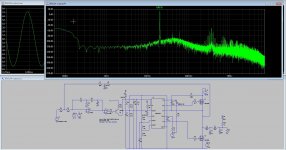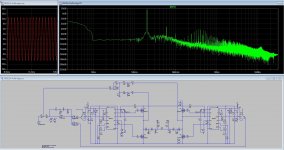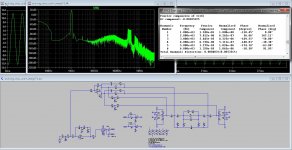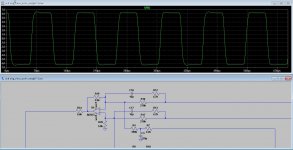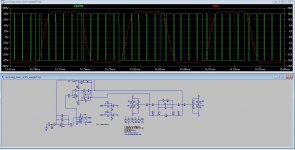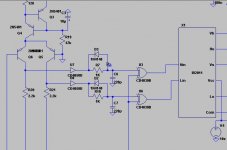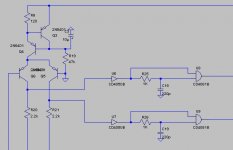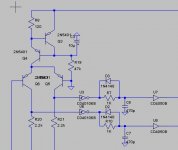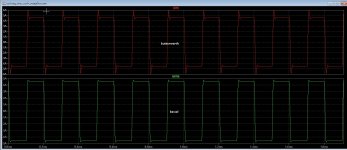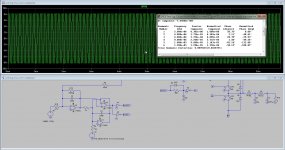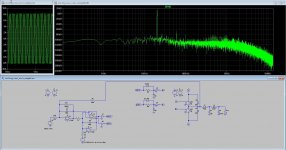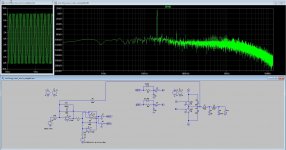I did find a nice model for the IRS20124, sims oke, and quite fast.
in fullbridge but has some trouble with offset.
regards
When you have LC filter outside feedback loop, you also have SPEAKER outside feedback loop !!! Change of speaker impedance (not constant) changes LC filter charactersitics. I would say that maybe real THD can be higher. (maybe, please comment)
Even classic AB class has feedback at the output, at the point of connection of speaker.
This would be great importance of UCD versus sigma delta.
I did find a nice model for the IRS20124, sims oke, and quite fast.
in fullbridge but has some trouble with offset.
regards
Maybe that single input type of MOSFET driver might tend to produce a bit of DC offset. I like that type though and would like to try it, but use just through hole parts as much as possible.
The offset is not a big problem, can be adjusted easely, as for grizlek, include a speaker terminal in the feedback of a AB amp is quite different from a class D amp, there is already a feedbackloop with analog delta sigma and UCD, I have now as requested include the coil into the loop, however, best did include the coil and before for switching loss correction, low pas filters tend to be quite nasty with square waves, I have here a test, with very low distortions, however when overdrive it it get unstable, this one needs a limiter, I did see one who seems work very good, not yet tested.
just let now what you see, for me it is just learning how these can be made, class d like easy but are not, square testing is somehwat different with ab amps.
Last picture was with two feedback opamps, did not make it better, so did now one opamp and network, and more power with lower distortion, do now, the switches are lossles, and there is deadtime and no overshoot.
regards
I go to sleep now.
just let now what you see, for me it is just learning how these can be made, class d like easy but are not, square testing is somehwat different with ab amps.
Last picture was with two feedback opamps, did not make it better, so did now one opamp and network, and more power with lower distortion, do now, the switches are lossles, and there is deadtime and no overshoot.
regards
I go to sleep now.
Attachments
When you have LC filter outside feedback loop, you also have SPEAKER outside feedback loop !!! Change of speaker impedance (not constant) changes LC filter charactersitics. I would say that maybe real THD can be higher. (maybe, please comment)
Even classic AB class has feedback at the output, at the point of connection of speaker.
This would be great importance of UCD versus sigma delta.
For clearance, I do NOT like feedback, so I do test also open loop versions and with prefeedback who tend,s not to get mess with sound, however this is class d so I can test all, and listen later, maybe a current feedbacked class D, because this feedback I do like much more because it is independent of bandwith, and have much less TIM distortions, these are very nasty sounding amps.
Some questions, what dead time generator for the IR2110 is best, there are different approaching's to do that.
here some I did find about it.
regards
here some I did find about it.
regards
Attachments
I have use two kind ow lowpass networks, both are 24db octave.
nice to see overshoot/ringing, the bessel network has the most nice waveform with little overshoot, and supress the carrier wel, however it is constand fase it has not constant amplitude.
-3dB om 100Khz.
regards
nice to see overshoot/ringing, the bessel network has the most nice waveform with little overshoot, and supress the carrier wel, however it is constand fase it has not constant amplitude.
-3dB om 100Khz.
regards
Attachments
A other tryout I have done with a second order fixed carrier modulator by insert a second integrator into the design with is clocked to make a triangle.
It give a very nice low distortion, and maybe it get even better.
is is done with 65 volts top top.
regards
It give a very nice low distortion, and maybe it get even better.
is is done with 65 volts top top.
regards
Attachments
@Kees52: Have you ever read ?http://www.mueta.com/MuetaAES112th5503AsyncSwitchHighEndAmp.pdf
tevens NL's ontwerp ; )
tevens NL's ontwerp ; )
@Kees52: Have you ever read ?http://www.mueta.com/MuetaAES112th5503AsyncSwitchHighEndAmp.pdf
tevens NL's ontwerp ; )
I have read a lot, there is so much about this class d stuff, these I did not yet read, but the sync stuff I did, this design I post has such thing keeping the carrier in his place when drive hard, it do not drop.
Still the best did the analog delta sigma amp, even without post feedback who I do not like because of fase shifts in the output coil, we can cancel this two poles there with a computing chip, a special one who do fases and put that into the loop wil stabilize it.
I did read some, it says also wath I mention, the current feedback option on the coil looks likt it effectively remove that fase stuff, it is just a coupled winding who follow the current in the coil, that can be much more stable, I did has a schematic drawn with it but not yet quite oke, the last post however is maybe a candidate.
Ja dat stomme nederlanders gedoe was altijd al nep, jaloezie?.
I read it thanks.
regards
Last edited:
This is a lowpass effect, coils do not like squares, she act as a buck converter with squares, and give overshoots, can be made less but stays a problem, high switching and 100 Khz bandwidth do work, but need very fast switching, can be done with totem pole 5 amp drivers? little overkill but is fast. Or I use 24 dB octave filters, the second coil is not of influence much.
Do you now what kind of symbol this is? I can not find it and do not now, I now the rest. see last picture.
regards
Do you now what kind of symbol this is? I can not find it and do not now, I now the rest. see last picture.
regards
Attachments
Last edited:
AC supply for T4
Can't the T4 be powered directly with 34-0-34 AC? Have you tried this option?
Regards ...
I have made and sold six T4s and are currently building a pair of T3 monoblocks with 44,000uf of Mundorf MLytic ultra low ESR filter caps.
Can't the T4 be powered directly with 34-0-34 AC? Have you tried this option?
Regards ...
I have read a lot, there is so much about this class d stuff, these I did not yet read, but the sync stuff I did, this design I post has such thing keeping the carrier in his place when drive hard, it do not drop.
Still the best did the analog delta sigma amp, even without post feedback who I do not like because of fase shifts in the output coil, we can cancel this two poles there with a computing chip, a special one who do fases and put that into the loop wil stabilize it.
I did read some, it says also wath I mention, the current feedback option on the coil looks likt it effectively remove that fase stuff, it is just a coupled winding who follow the current in the coil, that can be much more stable, I did has a schematic drawn with it but not yet quite oke, the last post however is maybe a candidate.
Ja dat stomme nederlanders gedoe was altijd al nep, jaloezie?.
I read it thanks.
regards
I don't know exactly what your background in electronics is but I wandered what your thoughts are about their approach.
En die laatste opmerking over 'was altijd nep, jaloezie' begrijp ik geloof ik niet zo goed
I don't know exactly what your background in electronics is but I wandered what your thoughts are about their approach.
En die laatste opmerking over 'was altijd nep, jaloezie' begrijp ik geloof ik niet zo goed

Dat nep nederlanders slaat op die uitdrukking, zeggen wel eens stomme nederlanders, maar hier komt goed spul vandaan.
Mine background with electronics is hobby wise, I have learn it myself, never had high school of such, I read much and try to learn, I did made in past one of the best fm transmittors for radio use 88 108 and digital encoders. I however are very bad in calculating things, I had always trouble with figures, I need software to do that, but never found one who can help.
But building amps is something I already do whole mine live, had myself a drive in show with all equipment out of mine hands, in 1978 I had one with 1000 watts output, the first mosfet from elector.
For class D these amps are very difficult to get right, I have ja alweer uit nederland seen a paper from our high school, making such rapport is quite full of figures, nothing for me, and I had no mony to study in mine time, I did go to work very early and become a shoe maker.
Here I have simulate a class D I get with perfect switches quite good hd figures. but in real time, I have to build it, the all digital class d has no real future I think, she will keep it analog self oscillating. I go see if I get a very fast and good switching output stage, maybe even with extra totem poles after the chip.
Last picture has a extra integrator who is driven by a clock making a triangle who is feed into the comparator, it is in the feedback loop and get quite nice results, clock jitter maybe a problem, and it is a constant carrier type now, no drop, without the clock it self oscillate and have drop, but very high frequency >1Mhz.
regards
Attachments
Last edited:
here some paper about class d with pid controller and capacitor current feedback, very nice and interesting with all the info. 1997 so it is a while ago, mueta based on this?.
https://www.google.nl/url?sa=t&rct=...573760-1.pdf&usg=AOvVaw06xi-RyZ7aYC8dAbjYufiv
here a model, did sim very low HD.
regards
https://www.google.nl/url?sa=t&rct=...573760-1.pdf&usg=AOvVaw06xi-RyZ7aYC8dAbjYufiv
here a model, did sim very low HD.
regards
Attachments
Last edited:
Haha André Veltman (which is mentioned in your paper) is one of the designers/engineers (together with Paul van der Hulst) of their Class D design (= Self-oscillating class-D amplifier design with output feedback), he runs PIAK electronics.
MUETA was the company they cooperated with regarding their Class D prints (components and IC).
PIAK publications
MUETA was the company they cooperated with regarding their Class D prints (components and IC).
PIAK publications
Last edited:
Haha André Veltman (which is mentioned in your paper) is one of the designers/engineers (together with Paul van der Hulst) of their Class D design (= Self-oscillating class-D amplifier design with output feedback), he runs PIAK electronics.
MUETA was the company they cooperated with regarding their Class D prints (components and IC).
PIAK publications
Mueta has that nice closed module of the pid controller, mention in the paper?.
this said, class d is not quite easy to get a good one, it is or low hd or unstability.
Nu zie je maar weer dat nederlanders niet zo dom zijn als andere denken.
- Home
- Amplifiers
- Class D
- What Class-D amp give best sound?
